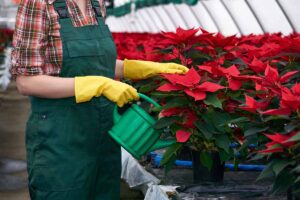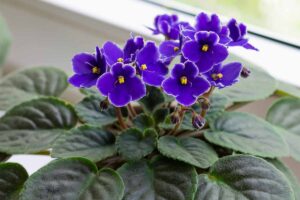Gynura aurantiaca
Aptly named, purple passion plant isn’t the type of houseplant that is likely to leave you feeling indifferent.
Its appearance is rather unusual, with furry purple leaves that have an iridescent glow when the light hits them at the right angle.

We link to vendors to help you find relevant products. If you buy from one of our links, we may earn a commission.
Houseplants can attract us for a variety of different reasons. Maybe African violets remind you of a favorite grandmother or aunt.
Perhaps poinsettias have you thinking about cheery holiday times. Or more practically speaking, snake plants may evoke simple lines useful in minimalist decor.
And then there are those species that are just exuberantly sense-provoking. They almost seem to be begging to be touched. Or their colors are so intriguing that you just can’t stop looking at them.
Purple passion plants have both of those last attributes – a beguiling coloration, as well as soft, velvety foliage. And those are far from their only desirable features.
Yes, there’s more, but you’ll have to read along to find out!
Ready to learn more about this ravishing houseplant – as well as how to care for it?
Here’s what we’ll cover:
What You’ll Learn
In case you’re experiencing any confusion that this is not the species you’re looking for, this article is about a species commonly grown as a houseplant – not to be confused with purple passionflower, a type of Passiflora that is grown outdoors for its delicious fruit!
What Is Purple Passion Plant?
Purple passion plant (Gynura aurantiaca) is an evergreen perennial loved for its violet tinged foliage.
When they are young, the plants have an upright growth habit, but once stems are longer, they start to sprawl and trail.
If you inspect an individual leaf, you’ll find it is more or less oval shaped, pointed, and with coarsely toothed margins. Leaves can grow up to eight inches long.
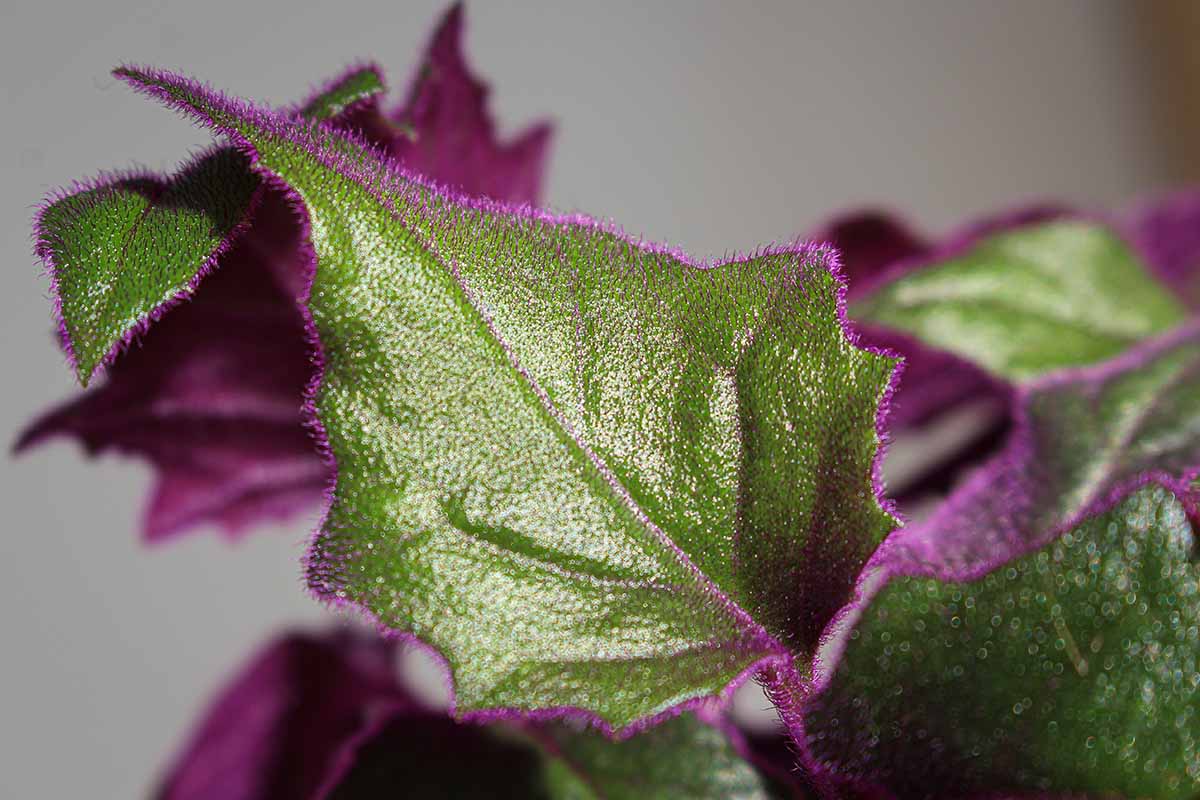
Of course the real fascination with G. aurantiaca is not the shape of the leaves – it’s their texture and beguiling coloring.
The leaves are green with purple undersides and are covered with small purple hairs which give the foliage a velvety texture and a purple glow.
The stems are covered with these purple hairs as well. New growth has a particularly bright coloring, as it is more densely covered with these hairs.
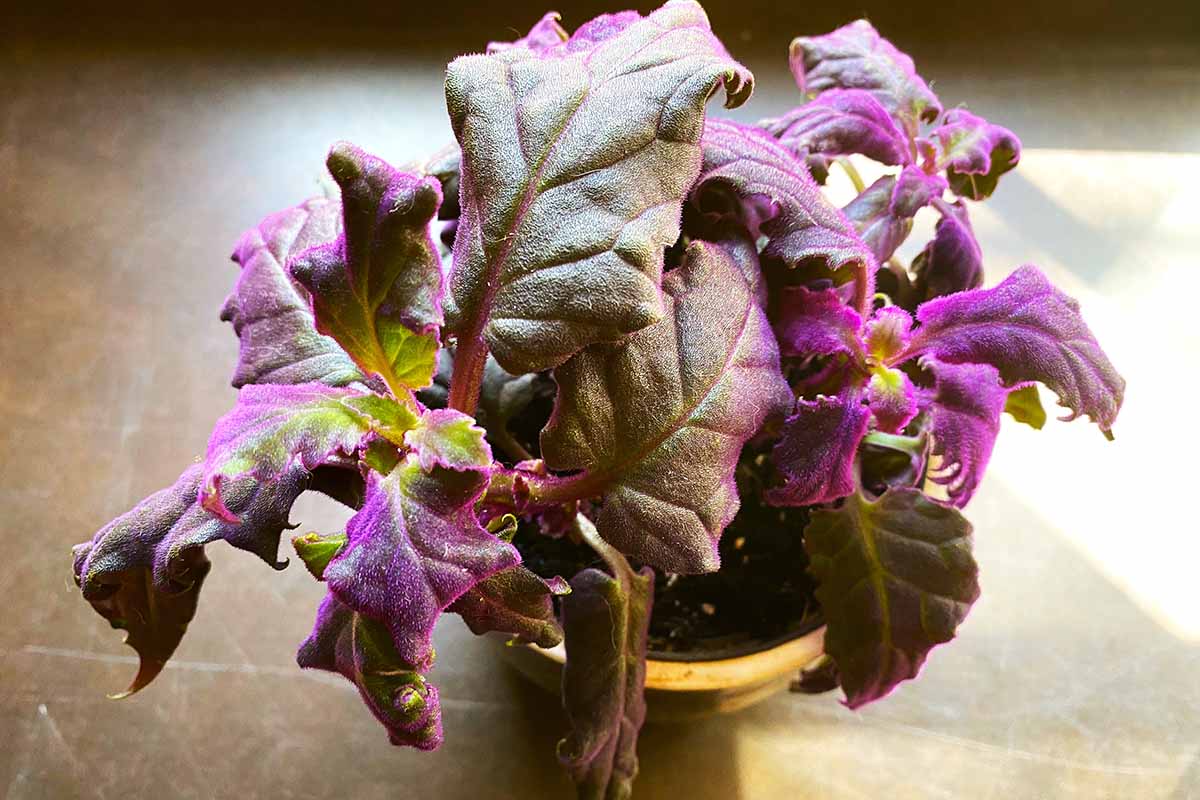
The shade of green on the leaves darkens with increased sun exposure, and they can even develop an almost black hue. (Ready for a black houseplant collection, anyone?)
Purple passion plants grow to be one to two feet tall, but their stems can trail to a length of four feet or more – making them excellent candidates for growing in hanging baskets.
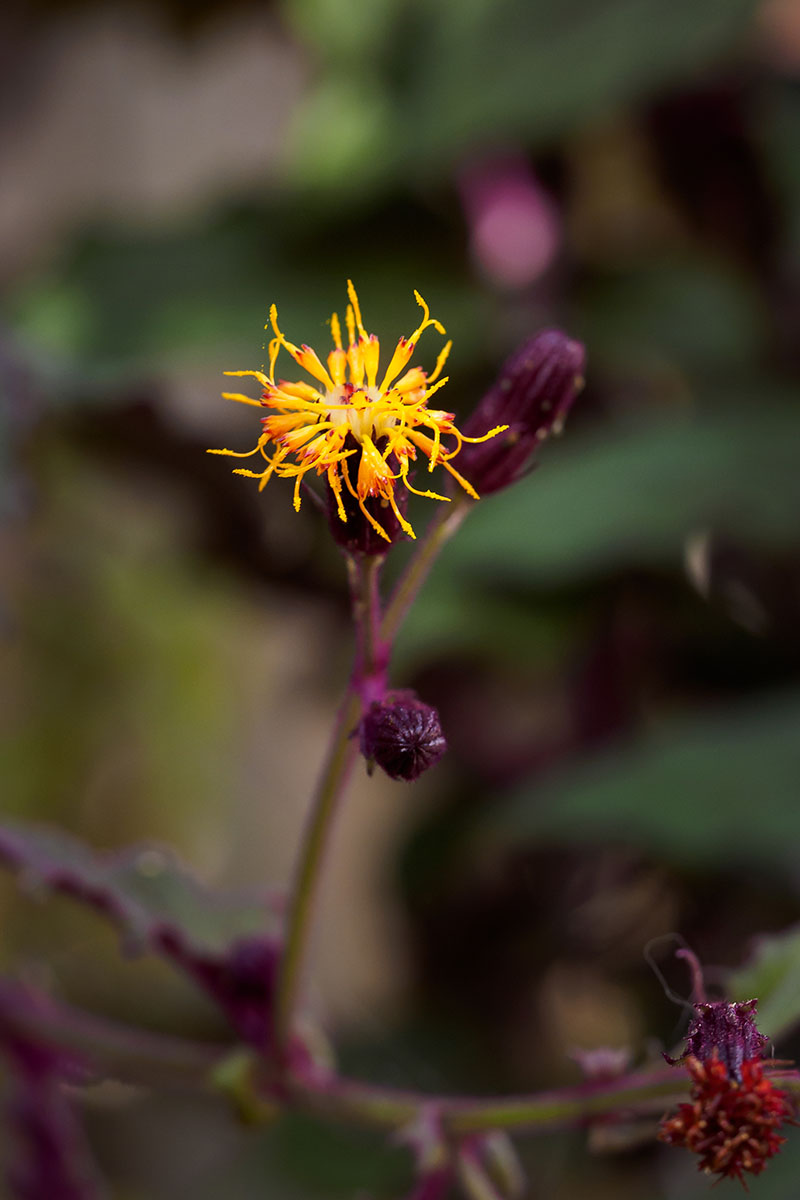
Flowers are yellowish orange and have a strong smell – some describe the smell as like that of rancid butter.
Others think the blooms smell like stinky socks, which is why most houseplant parents trim off any flower buds that appear before they open.
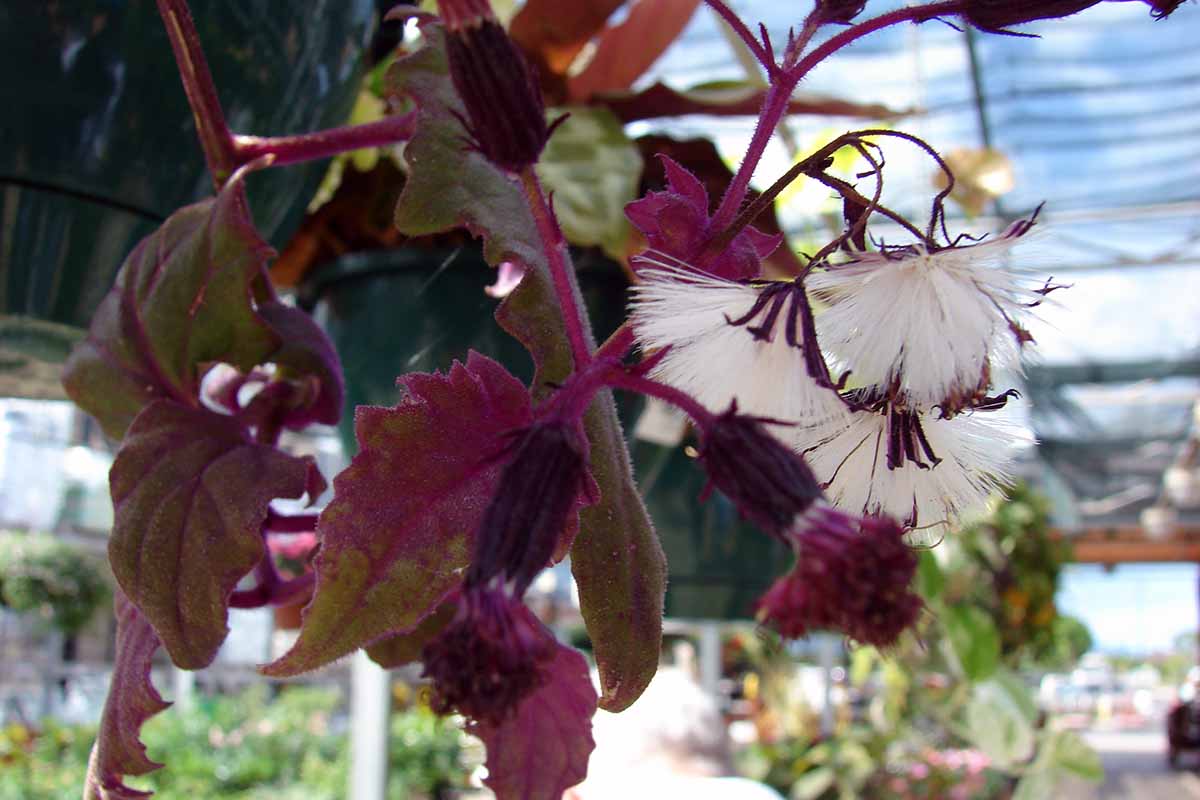
If flowers are allowed to remain, they transform into white puffballs of seed heads – reminiscent of the seed heads of their cousin, the dandelion.
Cultivation and History
Native to Indonesia, G. aurantiaca hails from a wet, tropical habitat where it grows as an understory plant.
A member of the sunflower family or Asteraceae, purple passion plant is related to many garden staples such as marigolds, lettuce, and asters, as well as houseplant favorites like string of pearls and gerbera daisies.
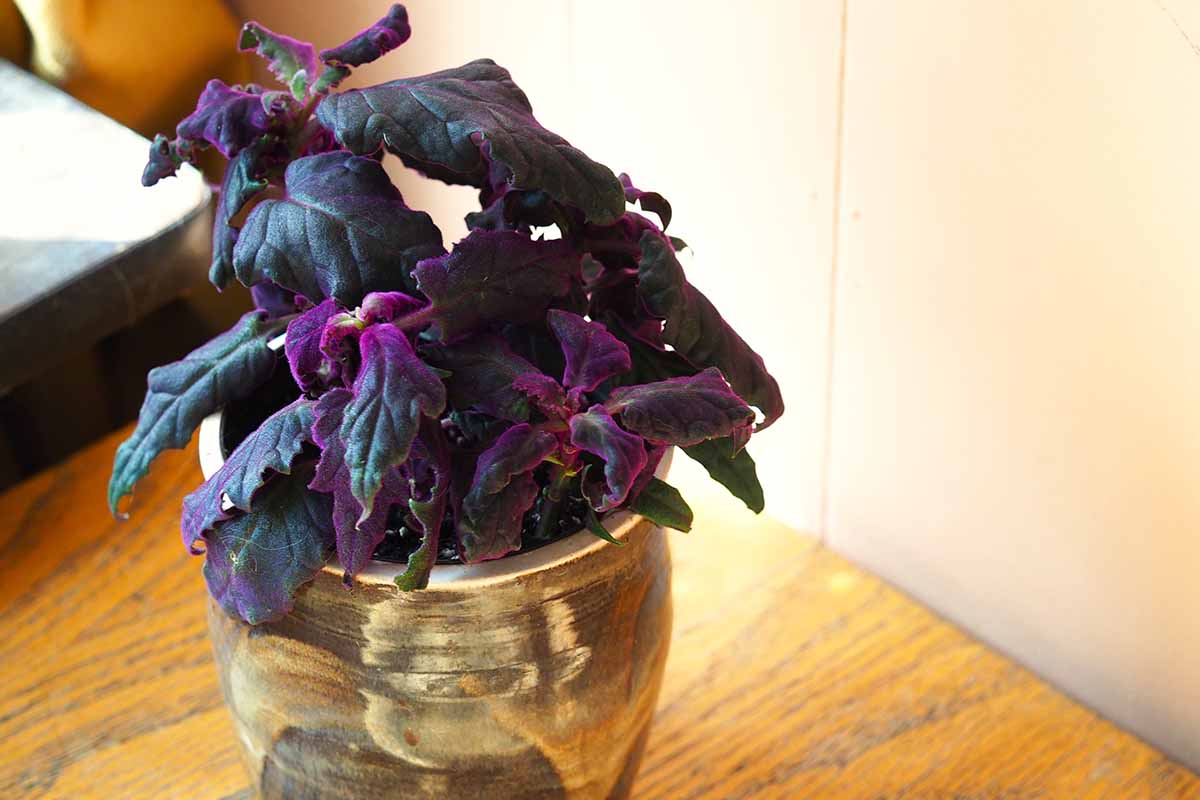
G. aurantiaca is also known as velvet, royal velvet, or purple velvet plant. In Indonesia it’s called “umyung.”
Purple passion plant may be the most well-known species in its genus, Gynura. A couple of other standout members of this genus are G. procumbens, known as “longevity spinach,” and G. bicolor, which is known as “Okinawan spinach.”
As for purple passion plant, it is considered nontoxic to humans, dogs, cats, and horses.
In fact, they contain antiviral properties and have been used medicinally by populations in their native regions.

While commonly used as an indoor, ornamental foliage plant, G. aurantiaca can also be grown outdoors year round in USDA Hardiness Zones 10 to 12.
Purple Passion Plant Propagation
Seeds for G. aurantiaca are not easily obtained, so the best way to propagate this houseplant is via cuttings.
From Cuttings in Soil
Luckily, propagating via stem cuttings is easy and can be done at any time of the year.
Here’s what you’ll need: a mature specimen to take cuttings from, sterilized scissors or snips, growing medium, nursery pots, a butter knife, and rooting hormone, also known as cloning hormone (optional).
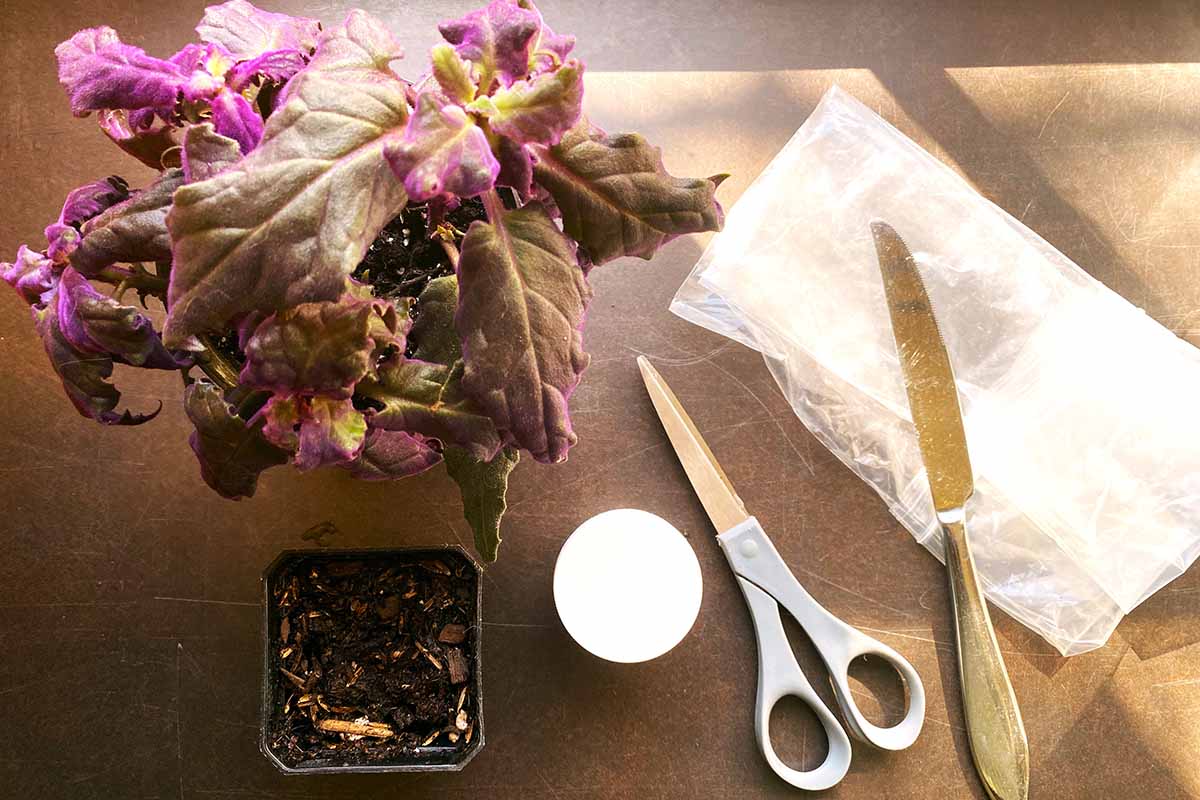
You can take your pick as to what size of pot to use – for instance, small, two- to three-inch nursery pots can be used for individual cuttings, or larger, six- to eight-inch pots can be used for multiple cuttings.
Fill the nursery pots with growing medium, leaving an inch between the surface of the soil and the rim of the pot to allow for watering.
Go ahead and wet the growing medium down after putting it in the nursery pots.
Next, use the butterknife to make holes in the growing medium. If you are using small nursery pots, make holes in the center of each one, or in the case of larger pots, space them two to three inches apart.
Now that the pots are ready, use the sterilized scissors or snips to take cuttings with at least two nodes, snipping right above a node. Remove the leaves from the bottom node.
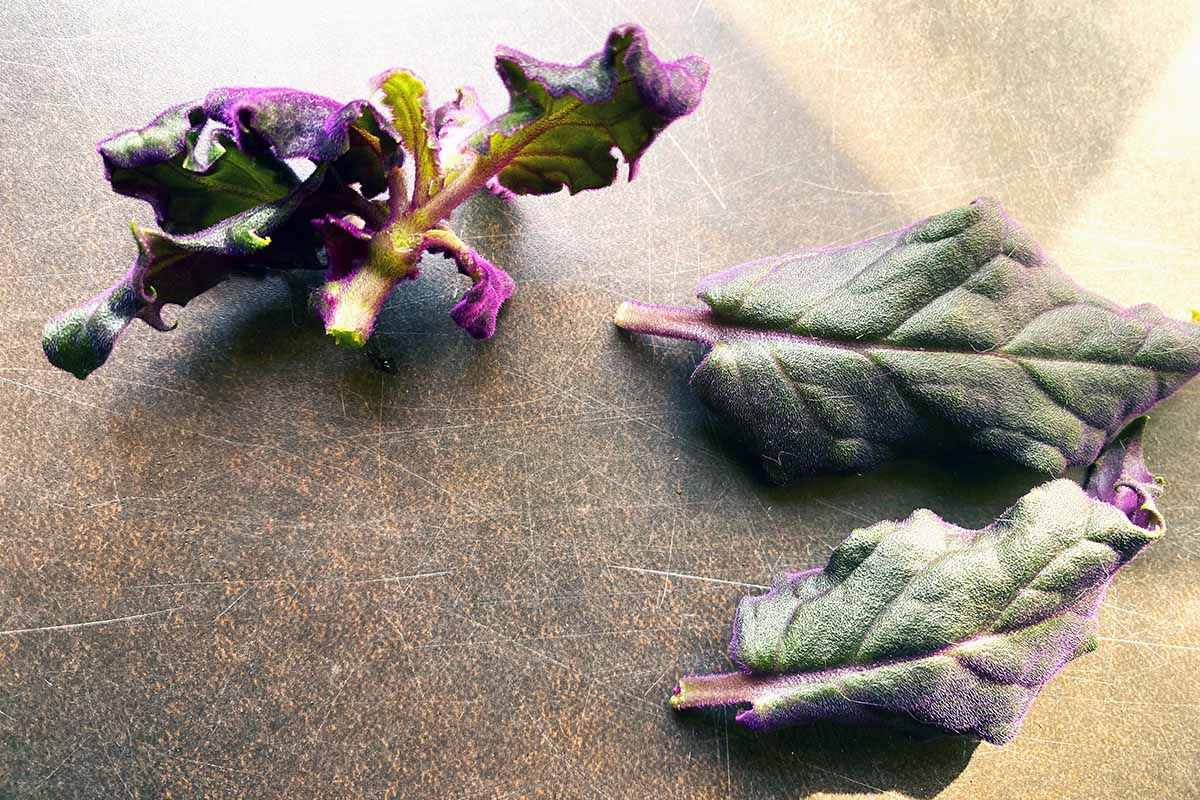
If you’d like to use rooting hormone – now’s the time to apply it. Dab the rooting hormone onto the bottom inch of the cutting, especially the cut stem.
Rooting hormone is optional, but can provide greater chances of success, and is a worthwhile product to keep on hand when you do your fair share of propagating!
Don’t have rooting hormone? You can purchase your own jar of Olivia’s Cloning Gel in an assortment of sizes via Arbico Organics.
After you have applied the rooting hormone (or decided to skip it), insert the cuttings into the holes.
Press the soil around the inserted end of the cutting to ensure good contact between the growing medium and the cutting. There’s no need to water since the growing medium should already be wet.
Place the pots in indirect light in a warm location, around 75°F is ideal, and keep the medium moist but not soggy.
If your home is on the dry side, offer the cutting a bit more humidity as it roots by placing a transparent plastic bag over the top to serve as a humidity dome.
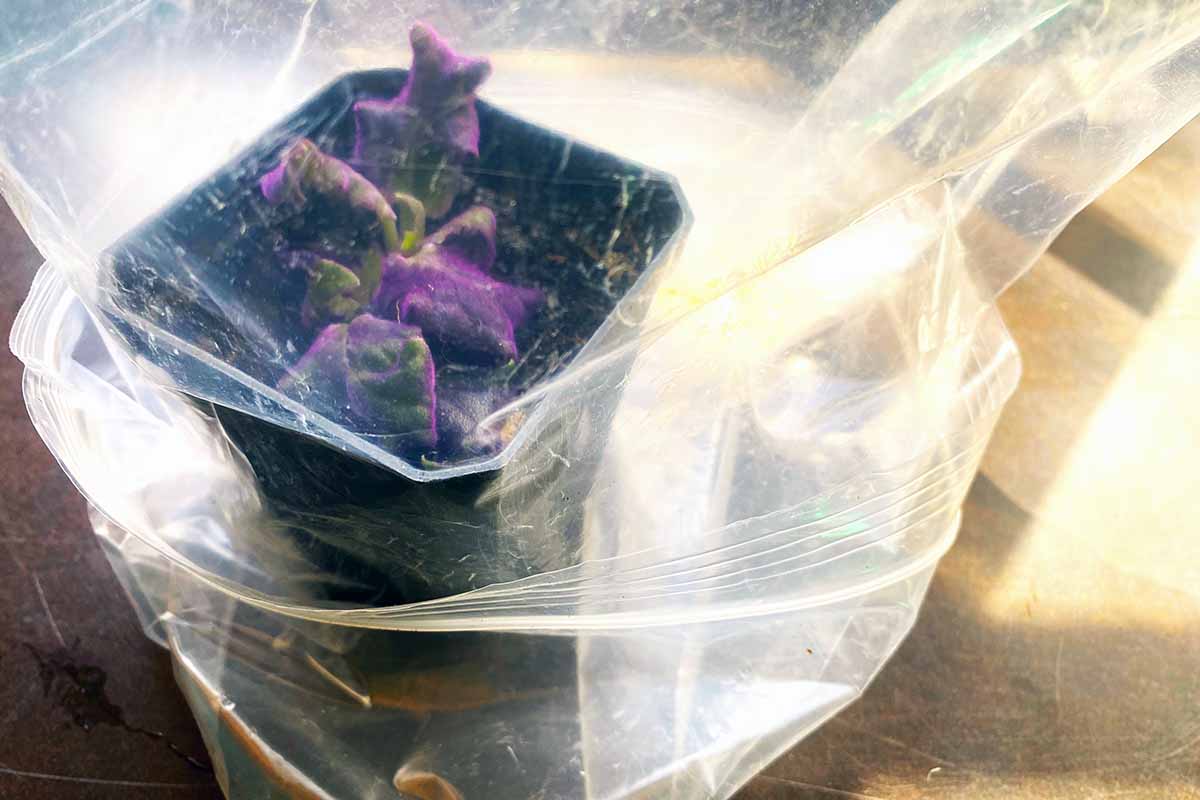
Rather than seal the nursery pot into the bag, keep it loosely covering the rooting cutting instead, to prevent the buildup of too much humidity. Remove the bag after three to four days.
Cuttings should root within one to two weeks. Once cuttings are rooted, they can be cared for as potted specimens.
From Cuttings in Water
Velvet plant cuttings are easy to root in water as well.
However, since many cuttings have a harder time adjusting to soil-based living after being rooted in water, this is more of a stopgap measure for when you have a cutting but don’t have time to pot it up properly.

Take cuttings with at least two nodes, remove the bottom two leaves, and place the cuttings in a transparent jar of water.
The recommendation to use a clear jar is not because the roots need light – it’s to help you notice when the jar needs refilling!
Place the jar in indirect light, in a location that is fairly warm – as close to 75°F as possible.
Add more water when the level dips, and change out the water entirely if it starts to look mucky.
When the roots are at least an inch long and you are ready to pot your water-grown cuttings, transplant them as indicated below in the repotting section.
How to Grow Purple Passion Plant
Velvet plants make low maintenance houseplants that are pretty easy to care for! Here’s what you’ll need to know:
They grow best and produce the most intense colors with bright or medium, indirect light.
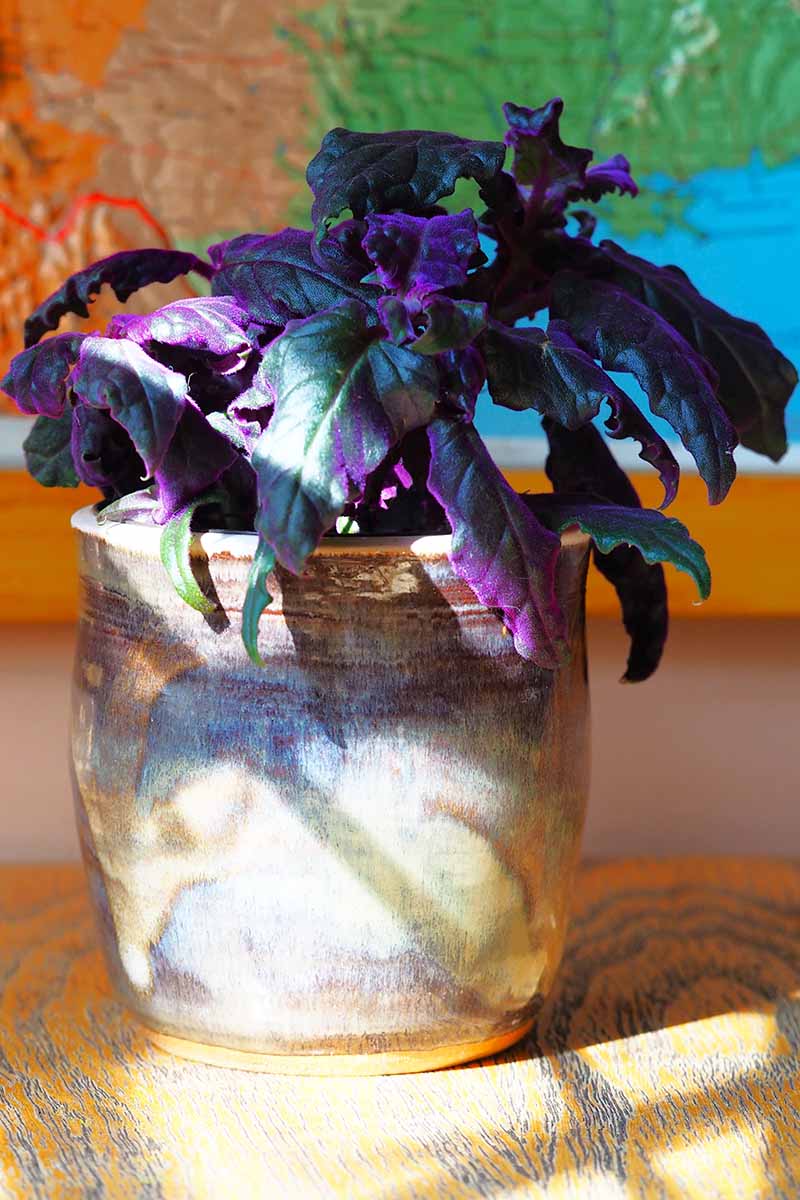
Although they can also be grown as low light houseplants, their foliage won’t be as colorful, and their growth will be leggier.
Not sure what kind of light you have available in your home for G. aurantiaca? Try checking with a light meter.
As for watering, it’s best to keep the growing medium consistently moist, but definitely not soggy.
A good rule of thumb is to let the surface of the potting medium dry between waterings.
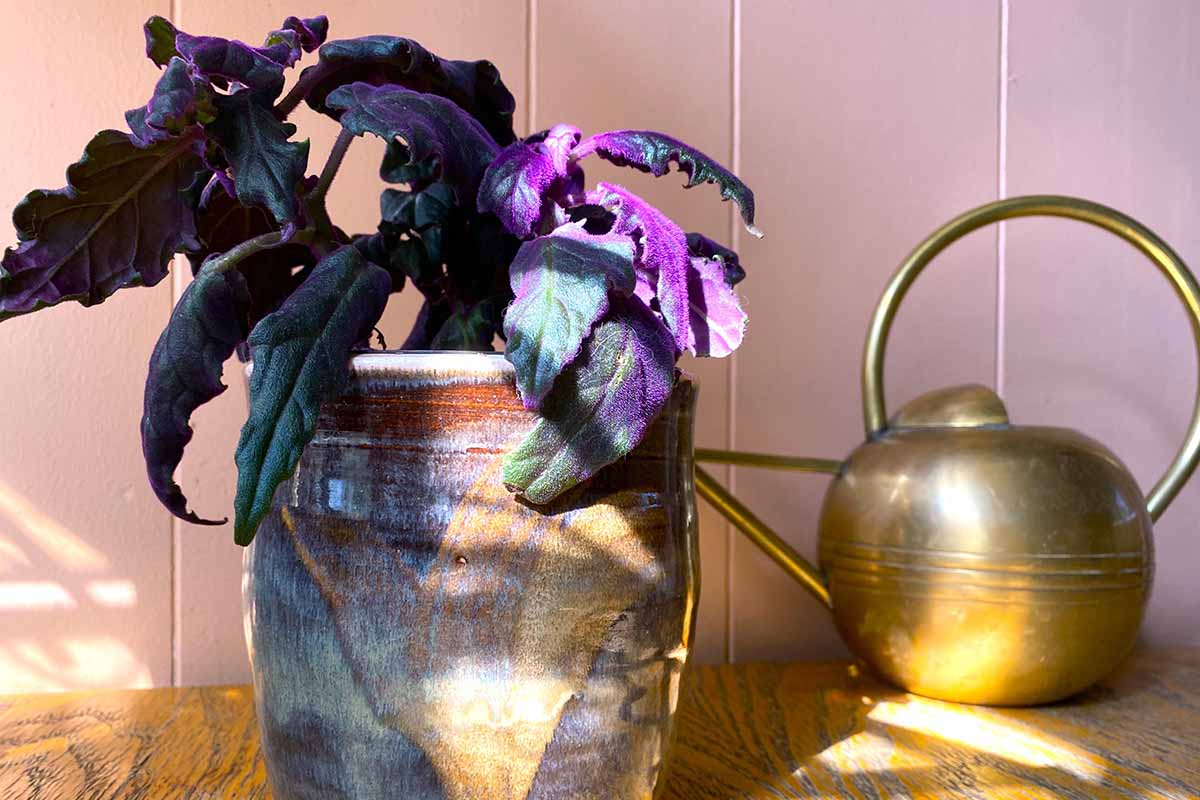
To prevent overly soggy conditions, make sure that both the pot and the growing medium are well-draining.
Using the right houseplant growing medium will also help prevent waterlogging.
One of my favorite growing mediums for houseplants, De La Tank’s from Tank’s Green Stuff, offers just the right combination of drainage and water retention for G. aurantiaca – plus, it’s peat-free.
De La Tank’s Soil Mix for Houseplants
De La Tank’s Soil Mix for Houseplants is available in an assortment of bag sizes from Tank’s Green Stuff via Arbico Organics.
You may also want to know what type of climatic conditions are best for this houseplant.
A relative humidity of 40 to 60 percent is considered ideal, while they exhibit the very best growth at temperatures of 75 to 80°F.
This temperature range is warmer than the average indoor conditions for folks living in centrally cooled and heated homes. That means you can place G. aurantiaca in warmer spots in your home if you really want to encourage your velvet plant to grow.
For instance, heat rises, so purple passion plants make good candidates for the “upper canopy” of your indoor jungle and can be placed on high shelves or elevated in hanging baskets to make use of those warmer microclimates.
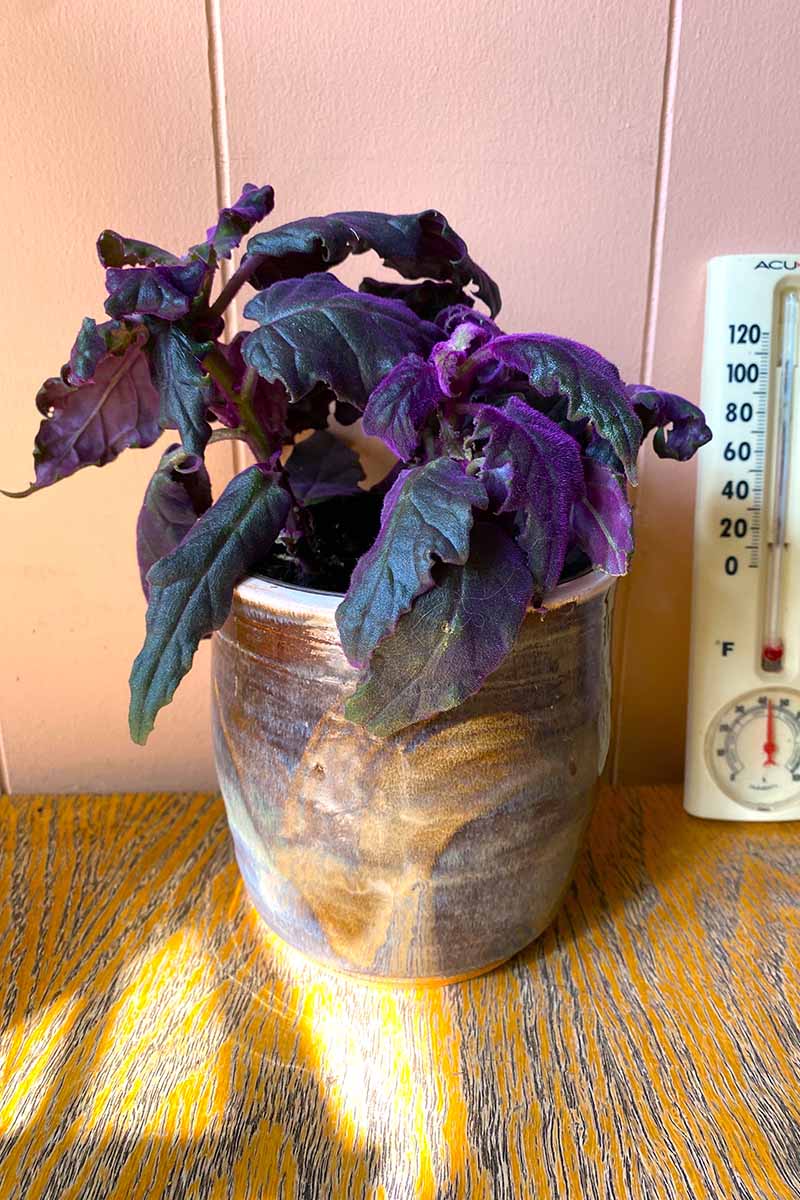
On the other hand, temperatures higher than 80°F will encourage leggy growth, so there’s no need to push up your thermostat all in the name of that indoor jungle.
And if you’re keeping your houseplant outdoors during the summer months, watch your weather report as the mercury starts to drop in fall – temperatures below 55°F can cause injury to the plant.
Growing Tips
- Grow in bright or medium, indirect light.
- Choose growing medium that is moisture retentive but has good drainage.
- Water when the surface of the soil is dry to the touch.
Pruning and Maintenance
Watering time is a good moment to inspect your houseplant. You might find some faded leaves in the center of the pot – just pick them out and throw them in your compost container.
Watch for flower buds – if you want to avoid the unpleasant smell that bothers some indoor gardeners (albeit others, not so much), you might want to snip them off before they have the chance to bloom.
As mentioned, G. aurantiaca can sometimes become leggy, with long vines and spaced out foliage.
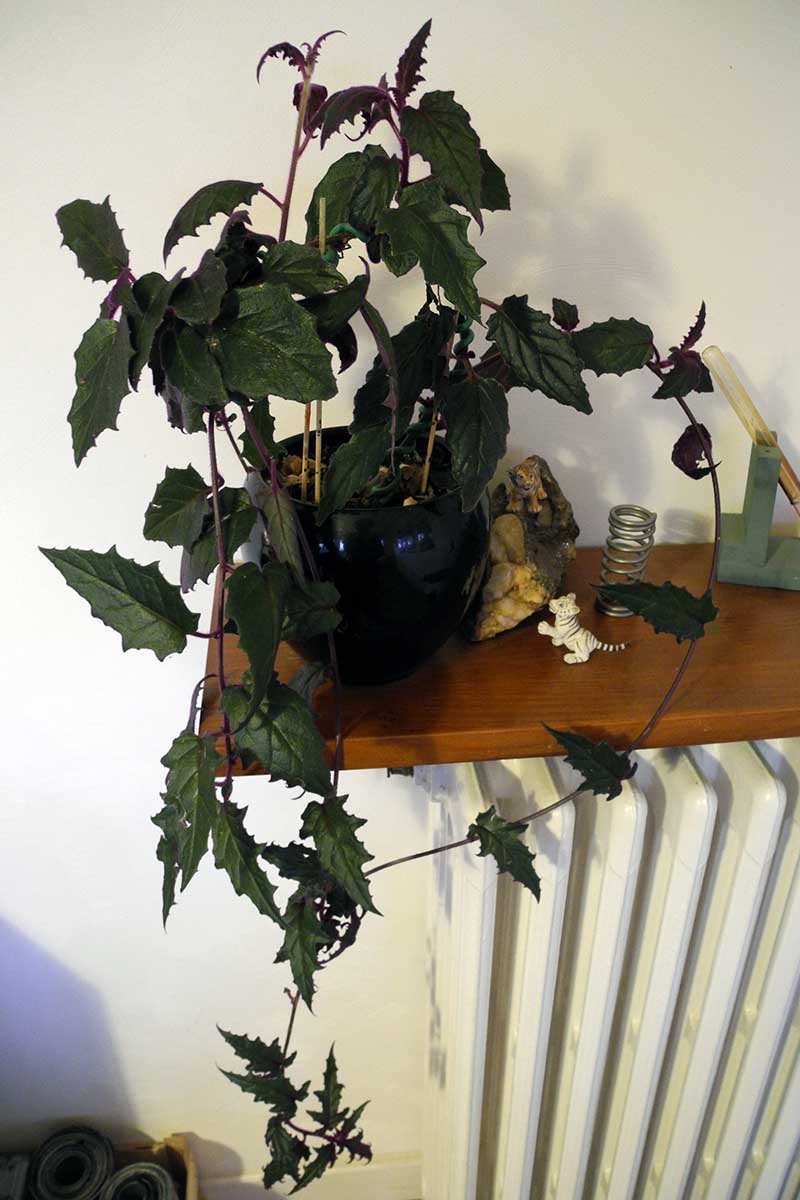
To encourage bushier growth, prune off the stems to the length you prefer. You can use the prunings to propagate more plants!
As for fertilizer, a gentle approach is best. And when it comes to plant nutrients, the best NPK ratio for G. aurantiaca is 3:1:3. However this ratio can be difficult to find in a ready-made fertilizer designed for home use.

Products with a ratio of 3:1:2 (NPK) will also work for this purpose, such as Mission Fertilizer’s Grow formula, available in quart or gallon containers via Amazon.
Fertilizer can be applied once a month throughout the year, but keep in mind that this can contribute to leggy growth, so feel free to reduce the frequency of feedings if plants are displaying a growth habit you don’t prefer.
Also be sure to follow the manufacturer’s instructions for applying any fertilizer you choose.
The only other maintenance item you’ll have to concern yourself with is repotting.
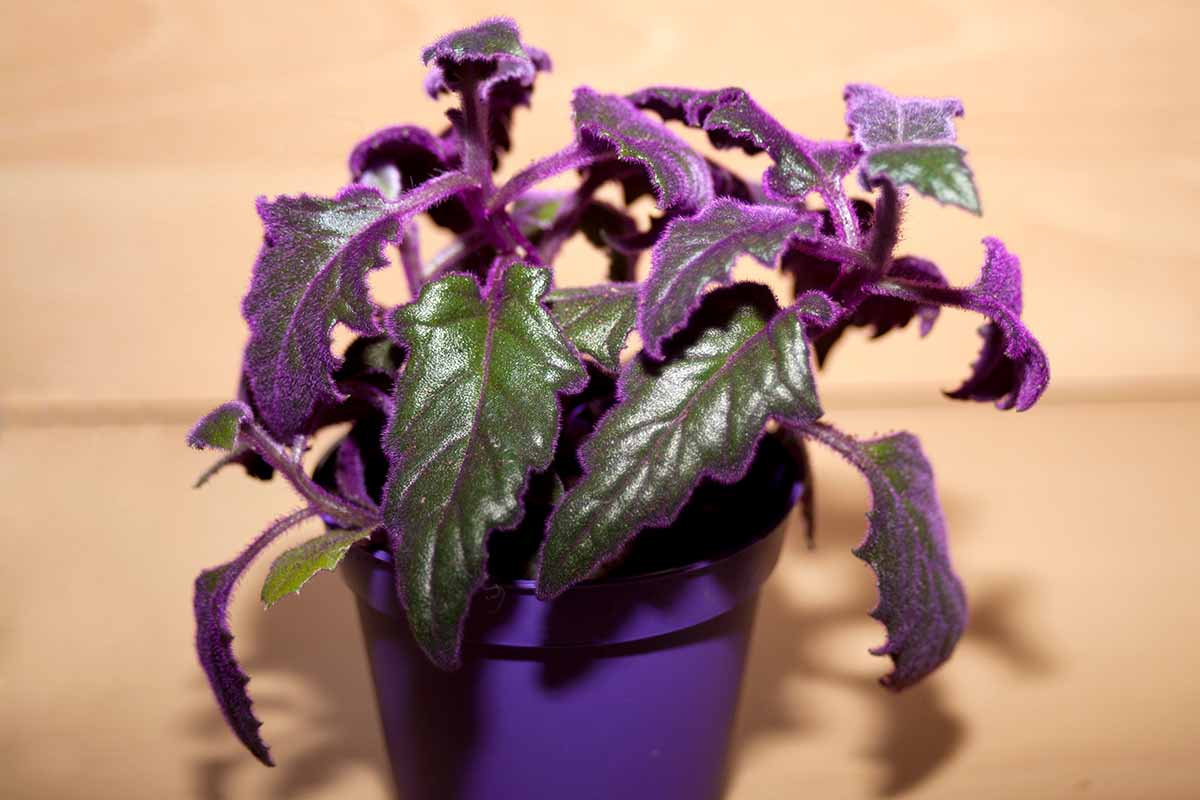
Plan to repot when plants start to become rootbound – or approximately every two years. Look for roots emerging from the drainage holes of pots, or specimens that need watering more often than you’re willing to accommodate.
When it’s time to repot, choose a container (with drainage holes!) that is just one size larger than the current pot.
Place some growing medium in the bottom of the new pot. Remove the specimen from its old container, loosen up the roots on the edges of the root ball, then place it in the new pot.
You may need to add or remove growing medium from the bottom of the pot to get the root ball situated at the right level – there should be about an inch of space between the top of the growing medium and the rim of the pot.
Once the plant is well situated, backfill with growing medium, then water in well.
Velvet Plant Cultivars to Select
You have a couple of options when choosing a velvet plant cultivar:
Purple Passion
‘Purple Passion’ is a cultivar of G. aurantiaca, and is the one you’re most likely to find for purchase as a houseplant.
This cultivar won the Royal Horticultural Society’s Award of Garden Merit in 1993 and has a more trailing growth habit than the straight species.
Live Purple Passion Plant in 4” Pot
You can purchase a live ‘Purple Passion’ plant in a four-inch pot from Rooted via Walmart.
Variegated Purple Passion
‘Variegated Purple Passion’ has green leaves with cream to pink variegation and is also covered with the same luxuriant layer of purple fur as the straight species.
This cultivar can be tricky to find, but is well worth seeking out.
Managing Pests and Disease
Purple passion plant is susceptible to the same types of houseplant diseases and pests most of us are familiar with.
However, healthy specimens will be less likely to be targeted or succumb to these attacks. So providing your velvet plant with the sun, soil, and climatic conditions it needs to thrive will provide the foundations of a healthy plant.
Check new specimens for signs of pests or diseases on arrival.
Also, it’s a good idea to keep new acquisitions in “quarantine” for the first two to four weeks in your home. This will allow any pests that may be lurking in the growing medium time to re-emerge, giving you the opportunity to treat the problem and prevent spread to other members of your houseplant community.
For plants already integrated into your home, each time you water, check stems and undersides of leaves as well as the top of the foliage, looking out for pests like aphids, mealybugs, scale, spider mites, and whiteflies.
The main disease you will have to look out for is root rot.
If your houseplant is wilting despite its growing medium being damp, root rot may be the reason.
This disease is the result of soil staying too soggy, which gives rise to pathogenic organisms.
The best way to deal with this disease is through prevention – make sure G. aurantiaca is grown in a pot with drainage holes, that its growing medium is well-draining, and that you don’t overwater.
Best Uses for Purple Passion Plant
This ornamental foliage plant can be enjoyed in several ways as a houseplant – beyond just serving as a beloved point of visual fixation!
Thanks to its trailing growth habit, it’s a no-brainer choice for a hanging basket, but if you’d rather keep it on a tabletop, it can be pruned for a more compact appearance.
The purple haze of velvet plant’s foliage may not blend into just any home decorating scheme as would say, a peace lily or cast-iron plant.
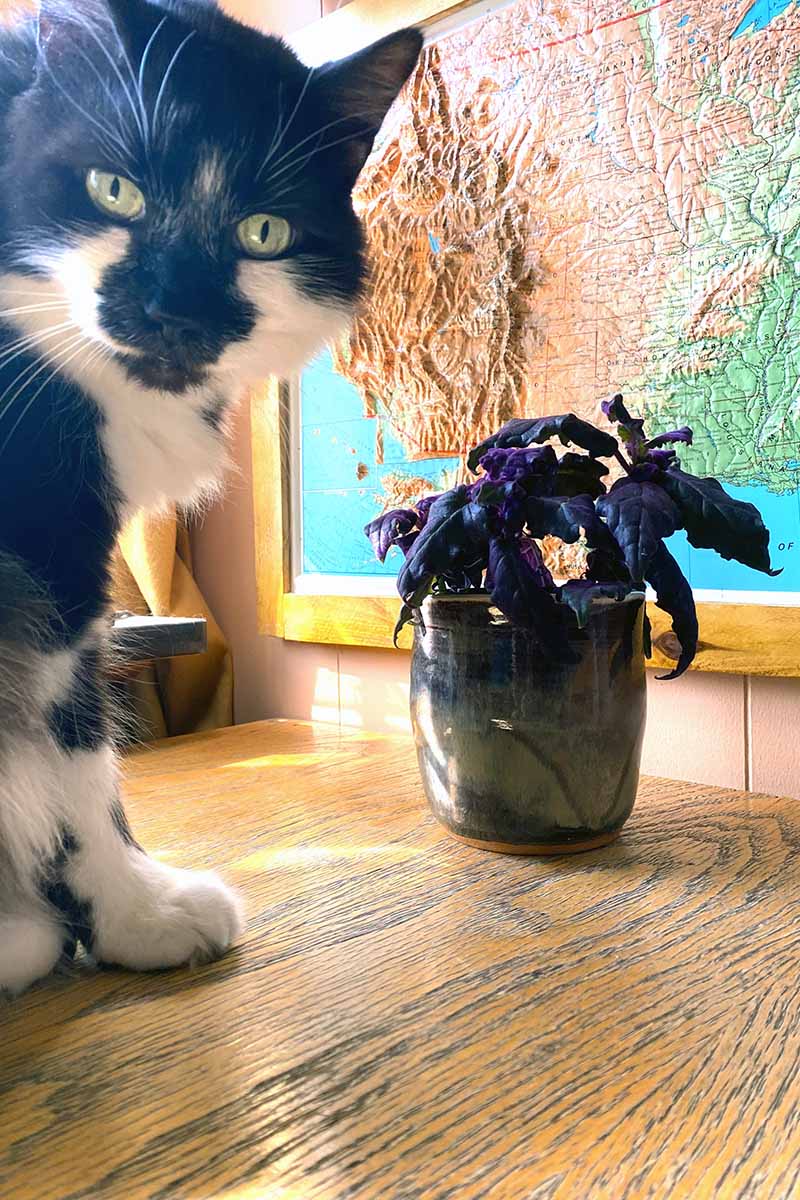
Yet, these violet-hued houseplants will look at home in many quirkier settings, such as spaces with an eclectic, goth, or psychedelic vibe – or anywhere where a visual splash of soft, velvety texture is desired.
Looking for companions for your purple passion plant? Group it with African violets, prayer plants, or spiderwort for houseplant buddies that not only look great together, but also share similar care preferences.
And making G. aurantiaca even more desirable in the living space, it is considered nontoxic so it’s safe for homes with small kids and curious pets.
Quick Reference Growing Guide
| Plant Type: | Evergreen perennial | Flower/Foliage Color: | Yellowish orange/purple, green |
| Native to: | Indonesia | Maintenance: | Low |
| Hardiness (USDA Zone): | 10-12 | Tolerance: | Humidity, low light |
| Bloom Time/Season: | Winter | Soil Type: | Houseplant soil |
| Exposure: | Bright to medium, indirect light | Soil pH: | 6.1-7.3 |
| Time to Maturity: | 3-5 years | Soil Drainage: | Well-draining |
| Planting Depth: | Top of root ball (transplants) | Companion Planting: | African violets, asparagus fern, begonias, ferns, prayer plants, spiderwort |
| Height: | 1-2 feet | Uses: | Hanging planters, interiorscapes, ornamental foliage, tabletops |
| Spread: | 4 feet | Family: | Asteraceae |
| Water Needs: | Moderate | Genus: | Gynura |
| Common Pests and Diseases: | Aphids, mealybugs, scale, spider mites, whiteflies; Downy mildew, root rot | Species: | Aurantiaca |
Voluptuously Velvety Vines
Not only does it have mesmerizing furry purple foliage, but this houseplant is also easy to propagate, a fast grower, tolerates low to medium light, and is nontoxic.
What’s not to feel passionate about?

Do you have any tips of your own about growing purple passion plant that you’d like to share with our readers? Or are you looking for help with your plant?
Be sure to drop us a line in the comment section below – we’d be happy to help. Oh, and if you happen to have a variegated velvet plant, let me know, I may know someone interested in cuttings. (I’m kidding! Maybe.)
Interested in perusing more houseplants to keep your velvet plant company? We have more ideas for you right here:



